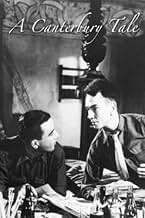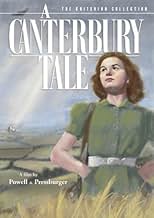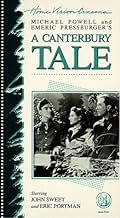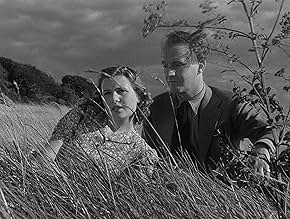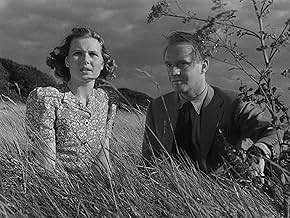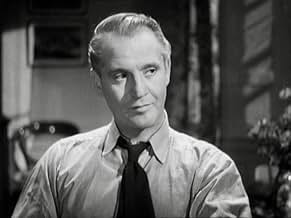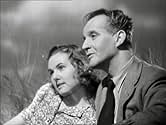Three modern-day pilgrims investigate a bizarre crime in a small town while on their way to Canterbury.Three modern-day pilgrims investigate a bizarre crime in a small town while on their way to Canterbury.Three modern-day pilgrims investigate a bizarre crime in a small town while on their way to Canterbury.
- Directors
- Writers
- Stars
- Sergeant Bob Johnson
- (as Sergt. John Sweet U.S. Army)
- Sergt. Bassett
- (as Antony Holles)
- Directors
- Writers
- All cast & crew
- Production, box office & more at IMDbPro
Featured reviews
The plot, such as it is, is bizarre. A small village in Kent is being terrorised by a madman who puts glue in women's hair during the blackout. The GI, the Sergeant and the Land Girl resolve to find the culprit.
All roads lead to Canterbury, where the Cathedral oversees the resolution of the mystery and of the disappointments in the characters' lives, before the soldiers set off on a more dangerous pilgrimage.
In the end, the plot is unbelievable, the character of Culpepper the magistrate unfathomable, the symbolism of the Cathedral laid on with a trowel - yet, why is this such a satisfying film? I think that there is a spirit which shines through this film - an optimism, a determination. The Land Girl has lost her Pilot fiancée, she grieves yet she is not downhearted. The GI loves and misses his homeland but can compare timber preparation techniques with the local blacksmith and find commonality. The English Countryside is ravishing throughout.
This film subtly highlights the values being fought for, the personal values, the village way of life, the spirit exemplified by the history of the Canterbury Pilgrims and of the Cathedral itself. And it is by tapping into the British psyche so deeply that even today it resonates which makes it a great film.
ACT is a pleasant inconsequential masterpiece, with no heavy points to labour, no axes to grind and for wartime not too many flags to wave. But it leaves you wishing that Olde England could've been better preserved from the elected savages in charge of us since, and that perhaps it wasn't so surprising that people were ready to defend such a country and its lifestyles to the death. The only thing Chaucer inspired in me in all of his tales was the desire to reach the end of the journey.
The story? Mysterious fetishist keeps pouring glue onto unsuspecting girls heads at night - 3 intrepid souls determine to find and unmask the weirdo, but vacillate when their moment comes. The four main characters weave in and out of the tale, moving it forward gently to the rather grand climax. But what about the Glueman himself - did he go back home to his reprehensible pastime or did he meet a sticky end? Did Bob get his marijuana? Did they manage to get the moths out of Allison's caravan? Did Peter ever stop playing on his organ?
Refreshing: 1/ A platonic relationship between three handsome men and one beautiful woman. 2/ The most violent scene is where the troops burst out clapping the Sgt. who repaired the slide projector. 3/ A basic plot premise so flimsy and yet so captivating.
A most profitable way of spending two hours.
The scope of the movie is amazing, and in 2 hours it covers enormous ground. The entire thing is so skillfully and assuredly done that in spite of the absence of any stars and (almost) of a story, and the fact that John Bull is never my companion of choice in any desert island, I was riveted to this movie. Besides the acting, this effect was achieved also by Alfred Junge's brilliant art direction (I couldn't believe the Canterbury church was just a set) and William Hillier's black and white photography. Two scenes stand out - a bird 'turning into' an airplane signifying time going on ahead by a few centuries, and an armoured car breaking through bushes and undergrowth (a very 'Predator'-ish shot).
This is a must see.
The only word I can find to give a flavour of this story is that it is above all English - as English as Ealing comedy (without the comedy), as Miss Marple (without the murder), as Elizabeth Goudge (without the magic)... and yet again I find myself defining it by what it *isn't*! It's English in a way that is quietly, deeply antithetical to the frenetic posturing of 'Cool Britannia'. It is as English as the haze over the long grass beneath the trees of a summer meadow; as polished brass and a whiff of steam as the express pulls up at a country halt; as church bells drifting in snatches on a lazy breeze, and the taste of blackberries in the sun.
It's almost impossible now to comprehend that the 1940s countryside in which this film is set was *really there*; that it was not the Second World War but its crippling aftermath that industrialised farms, banished the horse-drawn vehicles from the wheelwright's, and exchanged towering hay-wains for silage towers. Britain was determined never to starve again - and so the world that had once differed so little from that of Chaucer's time was swept away beyond recall. When it was made, this film was no more a rustic period piece than 'Passport to Pimlico', a few years later, was an urban social documentary. Subsequent events have preserved both in mute evidence of contemporary communities that are almost unbelievable today.
It is perhaps fair, therefore, to assume that the type of viewer who will watch 'Battlefield Earth' is unlikely to find this film anything other than silly, parochial and ultimately dull! Very little actually happens. The story is on occasion both humorous and poignant, but what we at first assume to be the central plot turns out not to be the point at all. The triple denouement is set up so gently and skilfully that we, too, are taken by miraculous surprise, with the true shape of the film only evident in retrospect.
It is, ultimately, a story about faith, and miracles, and pilgrimages, even in the then-modern world of shopgirls, lumbermen and cinema organists - and if that idea in itself sounds enough to put you off, as I confess it would have done for me before I watched it myself, then I will gladly add that it is a film about beauty, and hope, and unexpected friendship and laughter; and technically very accomplished to boot. The use of black and white is glorious, ranging from the glimmer in the obscurest of shadows to sun-drenched hillside, and the totally unselfconscious reference to Chaucer in the opening sequence is in these days worth the price of admission alone.
If you like gentle films - sweet-natured films - films with a deep affection for their subject - films that make you laugh and cry, but always smile - then I urge you not on any account to miss this one. If, for the moment, you require thrills, spills, forbidden passions and last-minute rescues, then pass it by and let it go on its tranquil way. When you are old and grey and full of sleep, this unassuming classic will still be there, waiting...
Did you know
- TriviaThe Archers (Michael Powell and Emeric Pressburger's production company) weren't given permission to film inside Canterbury Cathedral. In any case, the stained-glass windows had been taken out because of the air raids, the aisles were filled with sandbags and earth to fight fires and to provide a soft landing for any masonry or sculptures that fell there. So the interior of the Cathedral was rebuilt in Denham Studio. They recreated it so well that Cathedral guides have been heard telling people that the film was shot in there.
- GoofsA camera operator's shadow is clearly visible while Alison is riding a horse and buggy along the pilgrim's road.
- Quotes
Thomas Colpeper, JP: Well, there are more ways than one of getting close to your ancestors. Follow the old road, and as you walk, think of them and of the old England. They climbed Chillingbourne Hill, just as you. They sweated and paused for breath just as you did today. And when you see the bluebells in the spring and the wild thyme, and the broom and the heather, you're only seeing what their eyes saw. You ford the same rivers. The same birds are singing. When you lie flat on your back and rest, and watch the clouds sailing, as I often do, you're so close to those other people, that you can hear the thrumming of the hoofs of their horses, and the sound of the wheels on the road, and their laughter and talk, and the music of the instruments they carried. And when I turn the bend in the road, where they too saw the towers of Canterbury, I feel I've only to turn my head, to see them on the road behind me.
- Alternate versionsThe original UK version runs 124 minutes. For the USA release, the film was re-edited to 95-minutes and new footage starring Kim Hunter inserted:
- A scene between Bob (John Sweet) and his new bride Kim Hunter on the Rockefeller Center introduces the story which he then tells in flashback.
- The idyllic scenes with the boys' river battle and much of the hunt for the glue-man is cut with addition scenes or commentary by Bob added to cover the gaps.
- There is an additional epilogue with Bob and his girl at the tea-rooms in Canterbury.
- ConnectionsFeatured in Arena: A Pretty British Affair (1981)
- SoundtracksAngelus ad Virginem
(uncredited)
Traditional
Heard as a peal of bells in the opening titles
- How long is A Canterbury Tale?Powered by Alexa
Details
- Release date
- Country of origin
- Language
- Also known as
- Un cuento de Canterbury
- Filming locations
- Selling, Kent, England, UK(Railway station and signal box)
- Production companies
- See more company credits at IMDbPro
Box office
- Budget
- $650,000 (estimated)
- Gross worldwide
- $15
- Runtime2 hours 4 minutes
- Color
- Aspect ratio
- 1.37 : 1
Contribute to this page



